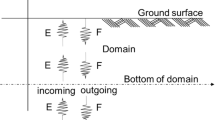Abstract
Discrete models such as the lumped parameter model and the finite element model are widely used in the solution of soil amplification of earthquakes. However, neither of the models will accurately estimate the natural frequencies of soil deposit, nor simulate a damping of frequency independence. This research develops a new discrete model for one-dimensional viscoelastic response analysis of layered soil deposit based on the mode equivalence method. The new discrete model is a one-dimensional equivalent multi-degree-of-freedom (MDOF) system characterized by a series of concentrated masses, springs and dashpots with a special configuration. The dynamic response of the equivalent MDOF system is analytically derived and the physical parameters are formulated in terms of modal properties. The equivalent MDOF system is verified through a comparison of amplification functions with the available theoretical solutions. The appropriate number of degrees of freedom (DOFs) in the equivalent MDOF system is estimated. A comparative study of the equivalent MDOF system with the existing discrete models is performed. It is shown that the proposed equivalent MDOF system can exactly present the natural frequencies and the hysteretic damping of soil deposits and provide more accurate results with fewer DOFs.
Similar content being viewed by others
References
Chopra AK (2007), Dynamics of Structures: Theory and Application to Earthquake Engineering, 3rd Edition, Prentice Hall.
Clough RW and Penzien J (2003), Dynamics of Structures, 3rd Edition, Computers and Structures, Inc.
Gazetas G (1982), “Vibrational Characteristics of Soil Deposits with Variable Wave Velocity,” International Journal for Numerical and Analytical Methods in Geomechanics, 6(1): 1–20.
Gladwell GML (2005), Inverse Problems in Vibration, 2rd Edition, In: Solid Mechanics and Its Applications 119, Kluwer Academic Publishers, New York.
Hardin BO and Drnevich VP (1972), “Shear Modulus and Damping in Soils: Measurement and Parameter Effects,” Journal of the Soil Mechanics and Foundations Division, ASCE, 98(6): 603–624.
Hashash YMA and Park D (2001), “Non-Linear One-Dimensional Seismic Ground Motion Propagation in the Mississippi Embayment,” Engineering Geology, 62(1-3): 185–206.
Idriss IM and Seed HB (1968), “Seismic Response of Horizontal Soil Layers,” Journal of the Soil Mechanics and Foundations Division, ASCE, 94(SM4): 1003–1031.
Kausel E and Roesset J (1984), “Soil Amplification: Some Refinements,” Soil Dynamics and Earthquake Engineering, 3(3): 116–123.
Kramer SL (1996), Geotechnical Earthquake Engineering, Prentice Hall, Upper Saddle River, N.J.
Lee MKW and Finn WDL (1978), “DESRA-2: Dynamic Effective Stress Response Analysis of Soil Deposits with Energy Transmitting Boundary Including Assessment of Liquefaction Potential,” Soil Mechanics Series, No.36, Department of Civil Engineering, University of British Columbia, Vancouver, Canada.
Li XS, Wang ZL and Shen CK (1992), “SUMDES: A Nonlinear Procedure for Response Analysis of Horizontally-layered Sites Subjected to Multi-directional Earthquake Loading,” Department of Civil Engineering, University of California, Davis, CA.
Lysmer J, Seed HB and Schnabel PB (1971), “Influence of Base-rock Characteristics on Ground Response,” Bulletin of the Seismological Society of America, 61(5): 1213–1231.
Matasovic N (1993), “Seismic Response of Composite Horizontally Layered Soil Deposits,” PhD dissertation, Civil and Environmental Engineering Department, University of California, Los Angeles, 452 p.
Matasovic N (2006), “D-MOD_2: A Computer Program for Seismic Response Analysis of Horizontally Layered Soil Deposits, Earthfill Dams, and Solid Waste Landfills,” User’s Manual, GeoMotions, LLC, Lacey, Wash., 20 p.
Nylen P and Uhlig F (1997), “Inverse Eigenvalue Problems Associated with Spring-Mass Systems,” Linear Algebra and its Applications, 254: 409–425.
Okamoto S and Tamura C (1973), “Behaviour of Subaqueous Tunnels During Earthquakes,” Earthquake Engineering and Structural Dynamics, 1(3): 253–266.
Pyke RM (2000), “TESS: A Computer Program for Nonlinear Ground Response Analyses,” TAGA Engineering Systems and Software, Lafayette, CA.
Roesset JM (1977), “Soil Amplification of Earthquake,” in C. S. Desai and JT Christian, Editors, Numerical Methods in Geotechnical Engineering, Chapter 19, John Wiley.
Roesset JM, Whitman RV and Dobry R (1973), “Modal Analysis for Structures with Foundation Interaction,” Journal of the Structural Division, ASCE, 99(3): 399–416.
Rovithis EN, Parashakis H and Mylonakis GE (2011), “1D Harmonic Response of Layered Inhomogeneous Soil: Analytical Investigation,” Soil Dynamics and Earthquake Engineering, 31(7): 879–890.
Schnabel PB, Lysmer JL and Seed HB (1972), “SHAKE: A Computer Program for Earthquake Response Analysis of Horizontally Layered Sites,” Report EERC-72/12, Earthquake Engineering Research Center, Berkeley, CA.
Stewart JP, Kwok AO, Hashash YMA, Matasovic N, Pyke RM, Wang ZL and Yang ZH (2008), “Benchmarking of Nonlinear Geotechnical Ground Response Analysis Procedures,” PEER Report 2008/04, Pacific Earthquake Engineering Research Center, College of Engineering, University of California, Berkeley.
Towhata I (1996), “Seismic Wave Propagation in Elastic Soil with Continuous Variation of Shear Modulus in the Vertical Direction,” Soils and Foundations, 36(1): 61–72.
Travasarou T and Gazetas G (2004), “On the Linear Seismic Response of Soils with Modulus Varying as a Power of Depth-The Maliakos Marine Clay,” Soils and Foundations, 44(5): 85–93.
Tsai NC and Housner GW (1970), “Calculation of Surface Motions of a Layered Half-space,” Bulletin of the Seismological Society of America, 60(5): 1625–1651.
Vrettos C (2013), “Dynamic Response of Soil Deposits to Vertical SH Waves for Different Rigidity Depth-Gradients,” Soil Dynamics and Earthquake Engineering, 47: 41–50.
Wolfram S (2010), Mathematica 8.0, Wolfram Research Inc.
Author information
Authors and Affiliations
Corresponding author
Additional information
Supported by: National Natural Science Foundation of China (51208296 & 51478343), Shanghai Committee of Science and Technology (13231200503), Fundamental Research Funds for the Central Universities (2013KJ095 & 101201438), Shanghai Educational Development Foundation (13CG17), and National Key Technology R&D Program (2012BAK24B04)
Rights and permissions
About this article
Cite this article
Li, C., Yuan, J., Yu, H. et al. Mode-based equivalent multi-degree-of-freedom system for one-dimensional viscoelastic response analysis of layered soil deposit. Earthq. Eng. Eng. Vib. 17, 103–124 (2018). https://doi.org/10.1007/s11803-018-0428-y
Received:
Accepted:
Published:
Issue Date:
DOI: https://doi.org/10.1007/s11803-018-0428-y




